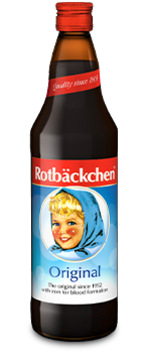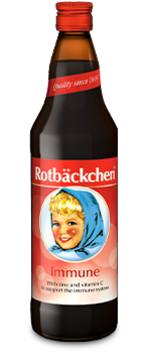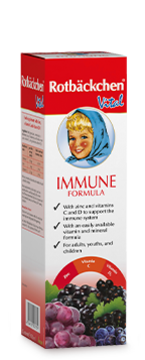Vitamin C
Our food provides us with many important nutrients that we need for good health every day. Vitamin C is an essential part of a varied and balanced diet, especially important for children who need sufficient vitamin C in their food. Here, you can read what vitamin C does to the body and what foods contain it.
What is vitamin C?
 Vitamins are organic compounds that support certain functions in the body. Since our body cannot produce many vitamins on its own, but needs them to stay healthy and functional, they have to be taken in regularly through food.
Vitamins are organic compounds that support certain functions in the body. Since our body cannot produce many vitamins on its own, but needs them to stay healthy and functional, they have to be taken in regularly through food.
One of the most important vitamins for the body is “ascorbic acid”, also called vitamin C. Vitamin C supports the body in numerous function. It is particularly well known as a supporter of an important protective mechanism - our immune system.
As the immune system of children is not yet fully developed, special attention should be paid to a balanced diet. Especially in the cold season, when the immune system is working at full capacity, sufficient vitamin C can make an active contribution to supporting the immune system of the little ones.
What are special features & effects of vitamin C?
As already mentioned, vitamin C contributes to normal immune system function. However, vitamin C has many other functions, because it contributes to:
- a normal mental function
- a normal nervous system
- a normal energy metabolism and reduced tiredness and fatigue
- the protection of cells from oxidative stress
Vitamin C also helps form collagen, which is important for normal blood vessels and skin. Collagen is also part of a functioning connective tissue - for children a rather long-term investment in health, but perhaps an interesting fact for you.
Interaction with iron
A special property of this well-known vitamin is that it helps the body to absorb iron. From a nutritional point of view, this offers many opportunities to solve two problems at once. By combining foods containing iron with foods containing vitamin C, an increased iron intake is ensured while at the same time providing a vitamin supplement. For example, meat and fish contain only small amounts of vitamin C but high iron content. By combining these foods with fresh vegetables or fruit in desert, your body absorbs iron better.
Which foods contain large amounts of vitamin C?
![[Translate to Englisch:] Zwei Acerola-Früchte hängen am Baum [Translate to Englisch:] Zwei Acerola-Früchte hängen am Baum](https://www.rotbaeckchen.de/fileadmin/_processed_/5/0/csm_rotbaeckchen-vitamin-C-03_461e0cbba2.jpg)
Vitamin C is found in many foods. Citrus fruit are especially known to have high vitamin C levels but not necessarily the highest among all fruit. Your children can find certainly plenty of different foods rich in vitamin C that they like.
These values only apply to the raw, fresh products. Because vitamin C is sensitive to light, heat and oxygen, it can be destroyed during food preparation. You can preserve the vitamin for you and your children by preparing the food gently or eating it raw.
Vitamin C sources in winter
Some of the fruits and vegetables listed above are not available fresh in winter or simply do not serve well in the cold season. To properly supply the immune system with the right amount of vitamin C, you can fall back on seasonal products.
| Fruit/vegetable | mg per 100 g |
|---|---|
| Rose hip | 1.250 mg |
| Sea buckthorn fruit | 450 mg |
| Parsley | 159 mg |
| Brussels sprouts | 112 mg |
| White cabbage | 52 mg |
Average values according to Souci, Fachmann, Kraut: Food Composition and Nutrition Tables (7th ed.). Munich: C.H. Beck. 2008
Daily vitamin C requirement
![[Translate to Englisch:] Kleinkind nascht Erdbeere beim ernten [Translate to Englisch:] Kleinkind nascht Erdbeere beim ernten](https://www.rotbaeckchen.de/fileadmin/_processed_/4/a/csm_rotbaeckchen-vitamin-C-04_47af3e2d0c.jpg)
How much do you really need? In order to ensure an optimal and needs-based vitamin C supply, the German Nutrition Society (DGE) provides guideline values for the recommended daily intake as a guide. The daily vitamin C requirement is determined by various aspects such as age, gender, height and weight. This means that vitamins for children have to be dosed differently than for adults.
| Vitamin C reference values | mg per day |
|---|---|
| Children between 1 and 4 years | 20 mg |
| Children between 4 and 7 years | 30 mg |
| Children between 7 and 10 years | 45 mg |
| Children between 10 and 13 years | 65 mg |
| Children between 13 and 15 years | 85 mg |
| Girls between 15 and 18 years | 90 mg |
| Boys between 15 and 18 years | 105 mg |
| Women 19 years and above | 95 mg |
| Men 19 years and above | 110 mg |
| Pregnant women | 105 mg |
| Breastfeeding women | 125 mg |
How harmful is an overdose of vitamin C?
With a healthy and balanced diet, you should not worry about vitamin C overdose. This is partially because preparing raw food significantly reduces its ascorbic acid content. However, if your children eat a lot of fruit and vegetables in summer, they might accidentally overdose on vitamin C. Normally, this imbalance only leads to diarrhoea and stomach upset.
Usually, the body simply excretes the excess vitamin C with urine. However, especially when reactions occur, you should not intentionally consume too much vitamin C. The recommended daily intake for food supplements should be followed.
The German Society for Nutrition (DGE) recommends 2 portions of fruit and 3 portions of vegetables per day as a guideline for a daily meal plan. If you and your family enjoy drinking juice, a glass of Rotbäckchen can also replace a portion of fruit.
More about vitamins & nutrients

Vitamins & minerals
Want to know what all the valuable micronutrients do, what foods have them and how much you need? Find more information here.
Find out more
Iron
Iron is one of the most important trace elements in the body. It helps red blood-cell formation and is essential for transporting oxygen through the body. The right iron balance helps you and your family stay healthy.
Find out more
Vitamin D
Vitamin D is the vitamin the body produces from sunlight when going for a walk or outside on the balcony. It is involved in many processes in the body and is indispensable for young children – in fact, it is not really a vitamin.
Find out more


